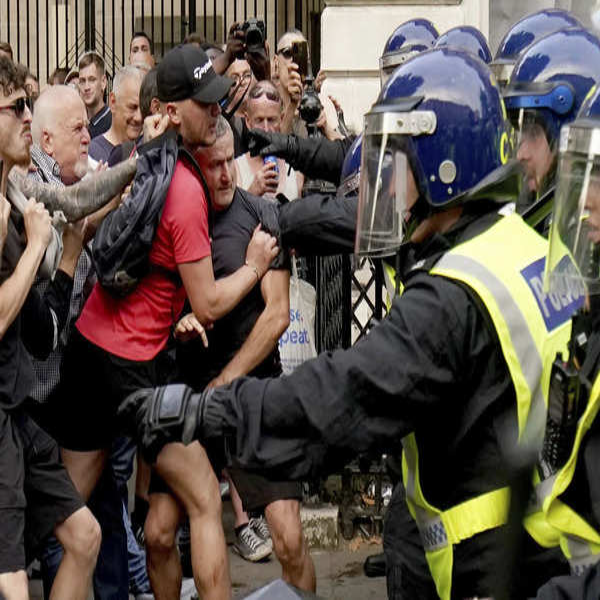Recent weeks have seen far-right rioters take to the streets of Britain, sparking fears and concerns among the country’s people of color and immigrant communities. These riots, fueled by anti-immigrant sentiments, have left many wondering if the country they call home is still a safe place for them.
The disturbing chant of “we want our country back” echoed through the streets, leaving a lasting impact on those who have always considered Britain their own. Dhruti Shah, a British citizen with Indian and Kenyan heritage, voiced a concern shared by many: “They were emboldened once, so who is not to say there won’t be flash points again?”
A partial sense of relief came on Wednesday when more than 100 anticipated anti-immigrant protests were met with massive counterprotests across the nation. Peaceful demonstrators carrying signs like “Refugees welcome” and “Racists not welcome here” successfully stifled the far-right’s agenda, but British authorities remain cautious, warning that further unrest could be on the horizon. The recent violence has exposed a passionate minority willing to act on their xenophobic and racist views.
The violence erupted after a stabbing in Southport that claimed the lives of three young children. Misinformation about the attacker’s identity and migration status spread like wildfire online, further fueling the flames. The attacker, Axel Rudakubana, a 17-year-old British citizen born in Wales to Rwandan parents, was falsely accused of being an illegal immigrant. The truth, however, did little to calm the growing unrest.
Far-right protesters attacked a hotel housing asylum seekers, assaulted police officers, and launched bricks and gasoline bombs at mosques. A Muslim bus driver was racially abused and spat on while working, highlighting the escalating hostility.
Even elected officials have not been immune to these tensions. Former Scottish First Minister Humza Yousaf, a Muslim born to Pakistani immigrants, recently expressed his fears about the rise of Islamophobia in Britain. He questioned whether his family’s future lies in the UK or even in Europe, revealing that he has received countless messages from Muslim families expressing similar concerns.
Shah, 42, lamented how the riots diverted attention from the tragic deaths of the three girls in Southport. While the counterprotests offered some comfort, she warned that they do not erase the deep-seated issue of racism in Britain.
As of Sunday, over 700 arrests had been made in connection with the unrest. In response, the British government has introduced emergency security measures for mosques, a move welcomed by the Muslim Council of Britain. Zara Mohammed, the Council’s secretary general, acknowledged the reassurance provided by the counterprotests but noted that many Muslim and minority communities continue to feel a deep sense of fear and anxiety.
Amy, a 34-year-old teacher from London, described feeling vulnerable for the first time because of her skin color. Normally unafraid, she found herself making arrangements to avoid potential unrest during the protests, even considering moving out of her beloved Walthamstow.
The unrest led to widespread disruptions across the country. Doctor’s offices closed early, shops boarded up, and theater shows were canceled in anticipation of violence. London Mayor Sadiq Khan urged the public to check in on their Black, Brown, and minority friends, acknowledging the widespread fear in these communities.
Khan later admitted that the far-right riots had “triggered” him, recounting how his children’s generation, who had never experienced such fear, were now scared for the first time. “I thought I’d be the last generation to be scared, simply for who I am,” he said.
The riots have not only exposed societal cracks but have also strained personal relationships. Shah recounted being chastised by a White friend for making them uncomfortable by discussing the riots. Her response was clear: “Now you know what it’s like for people of color in this country.”
Despite the turmoil, the counterprotests have brought some hope. Amy, who did not attend the Walthamstow protest, was reassured by a White friend who told her, “It’s not for you to go; it’s for us to show up in the places where you don’t feel safe.” The sight of anti-racism protesters flooding the streets of her hometown restored her faith in London and renewed her love for Walthamstow.
In the face of the far-right threat, the people of Walthamstow stood defiantly, saying, “Absolutely not.” Their actions provided a sense of safety and solidarity to people of colour and other minorities across the nation, reminding everyone that the fight against racism is far from over.



